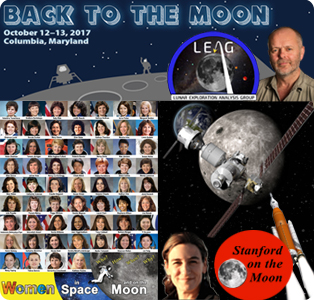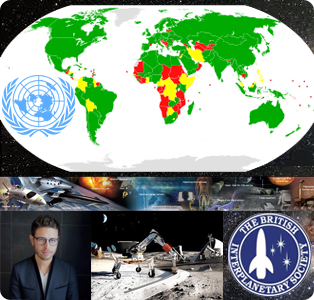First Woman on the Moon Next Steps at LEAG and SOM
|
MONDAY Ongoing…
|

![]() = All times
= All times
for terrestrial events in local time unless noted.
![]() = All times for international terrestrial events in local time unless noted.
= All times for international terrestrial events in local time unless noted.
![]() = All times for space events, and…
= All times for space events, and…
![]() = All times for international space / astro events in Hawaii Standard Time unless noted. Add 10 hours to obtain UT (‘Universal Time;’ Greenwich, England).
= All times for international space / astro events in Hawaii Standard Time unless noted. Add 10 hours to obtain UT (‘Universal Time;’ Greenwich, England).
Weekly Planet Watch – Evening Planets: Saturn (SW), Uranus (E), Neptune (SE); Morning Planets: Mars (E), Venus (E).
Outer Space Treaty Celebrates Golden Jubilee As Many See New Era of Commercial Opportunities Rising
|
Continued from…
|
TUESDAY
![]() Oct 10 — ISS, Expedition 53 U.S. EVA #45, 330-435-km LEO: Commander Randy Bresnik and Mark Vande Hei to perform second of three 6.5-hour spacewalks to replace one of two latching end effectors on the tip of Canadarm2, lubricate new component and replace cameras at two locations on station truss; live coverage available.
Oct 10 — ISS, Expedition 53 U.S. EVA #45, 330-435-km LEO: Commander Randy Bresnik and Mark Vande Hei to perform second of three 6.5-hour spacewalks to replace one of two latching end effectors on the tip of Canadarm2, lubricate new component and replace cameras at two locations on station truss; live coverage available.
![]() Oct 10 — United Nations Outer Space Treaty (OST) 50th Observation, Worldwide: OST framework to address legal questions for capabilities and activities in Space entered into force by United Nations General Assembly on this day in 1967; evolving / unfolding regulations include commercial space activities, private space stations, habitats on Moon, asteroid mining, contamination of celestial bodies.
Oct 10 — United Nations Outer Space Treaty (OST) 50th Observation, Worldwide: OST framework to address legal questions for capabilities and activities in Space entered into force by United Nations General Assembly on this day in 1967; evolving / unfolding regulations include commercial space activities, private space stations, habitats on Moon, asteroid mining, contamination of celestial bodies.
![]() Oct 10 — British Interplanetary Society, London, United Kingdom: Symposium: 50 Years of the UN Space Treaty – Looking Back, Looking Forward.
Oct 10 — British Interplanetary Society, London, United Kingdom: Symposium: 50 Years of the UN Space Treaty – Looking Back, Looking Forward.
![]() Oct 10 — TMT Observatory Corporation, Pasadena CA: TMT Board Meeting.
Oct 10 — TMT Observatory Corporation, Pasadena CA: TMT Board Meeting.
![]() Oct 10-11 — Air & Space Academy, Toulouse, France: International Conference on The Climate Needs Space.
Oct 10-11 — Air & Space Academy, Toulouse, France: International Conference on The Climate Needs Space.
![]() Oct 10-12 — IEEE, Montreal, Quebec, Canada: 5th Annual IEEE International Conference on Wireless for Space and Extreme Environments (WISEE 2017); brings together NASA, CSA, ESA, other space agencies with aerospace and space defense industries and academic researchers.
Oct 10-12 — IEEE, Montreal, Quebec, Canada: 5th Annual IEEE International Conference on Wireless for Space and Extreme Environments (WISEE 2017); brings together NASA, CSA, ESA, other space agencies with aerospace and space defense industries and academic researchers.
![]() Oct 10-12 — Lunar Exploration Analysis Group, Columbia MD: Annual Meeting of LEAG: Activities Enabled by Getting to the Lunar Surface.
Oct 10-12 — Lunar Exploration Analysis Group, Columbia MD: Annual Meeting of LEAG: Activities Enabled by Getting to the Lunar Surface.
![]() Oct 10 — Moon: 4.8° S of M35 cluster, 22:00.
Oct 10 — Moon: 4.8° S of M35 cluster, 22:00.
![]() Oct 10 — Apollo Asteroid 2014 DQ: Near-Earth Flyby (0.082 AU).
Oct 10 — Apollo Asteroid 2014 DQ: Near-Earth Flyby (0.082 AU).
WEDNESDAY
![]() Oct 11 — Foothill College, Astronomical Society of the Pacific, SETI, Ames Research Center, NASA, Los Altos Hills CA: Silicon Valley Astronomy Lecture Series: Will the 21st Century be the Time We Discover Life Beyond Earth? by Jill Tarter of SETI, 19:00.
Oct 11 — Foothill College, Astronomical Society of the Pacific, SETI, Ames Research Center, NASA, Los Altos Hills CA: Silicon Valley Astronomy Lecture Series: Will the 21st Century be the Time We Discover Life Beyond Earth? by Jill Tarter of SETI, 19:00.
![]() Oct 11-12 — ISPCS, New Mexico Space Grant Consortium, Las Cruces NM: International Symposium for Personal and Commercial Spaceflight 2017 (ISPCS 2017): Go For Purpose.
Oct 11-12 — ISPCS, New Mexico Space Grant Consortium, Las Cruces NM: International Symposium for Personal and Commercial Spaceflight 2017 (ISPCS 2017): Go For Purpose.
![]() Oct 11 — Moon: 1.5° N. of asteroid 8 Flora, 14:00.
Oct 11 — Moon: 1.5° N. of asteroid 8 Flora, 14:00.
![]() Oct 11 — Aten Asteroid 2017 SB20: Near-Earth Flyby (0.023 AU).
Oct 11 — Aten Asteroid 2017 SB20: Near-Earth Flyby (0.023 AU).
![]() Oct 11 — Apollo Asteroid 2007 DM41: Near-Earth Flyby (0.090 AU).
Oct 11 — Apollo Asteroid 2007 DM41: Near-Earth Flyby (0.090 AU).
THURSDAY
![]() Oct 12 — Roscosmos State Corporation, Launch Soyuz / Progress 68P (MS-07), Baikonur Cosmodrome, Kazakhstan: Russia Soyuz rocket to launch Progress 68P resupply ship to ISS.
Oct 12 — Roscosmos State Corporation, Launch Soyuz / Progress 68P (MS-07), Baikonur Cosmodrome, Kazakhstan: Russia Soyuz rocket to launch Progress 68P resupply ship to ISS.
![]() Oct 12-13 — Lunar Exploration Analysis Group, Columbia MD: Back to the Moon Workshop; bringing together stakeholders from industry, commerce, government, and academia to explore making a lunar return with humans an affordable reality in the near future.
Oct 12-13 — Lunar Exploration Analysis Group, Columbia MD: Back to the Moon Workshop; bringing together stakeholders from industry, commerce, government, and academia to explore making a lunar return with humans an affordable reality in the near future.
![]() Oct 12 — Apollo Asteroid 2012 TC4: Near-Earth Flyby (0.0003 AU); NASA to test its asteroid detection and tracking capabilities.
Oct 12 — Apollo Asteroid 2012 TC4: Near-Earth Flyby (0.0003 AU); NASA to test its asteroid detection and tracking capabilities.
![]() Oct 12 — Moon: At last quarter, 02:26; 12.8° S of Castor, 06:00; 9.2° S of Pollux, 11:00.
Oct 12 — Moon: At last quarter, 02:26; 12.8° S of Castor, 06:00; 9.2° S of Pollux, 11:00.
![]() Oct 12 — Apollo Asteroid 2017 RV1: Near-Earth Flyby (0.046 AU).
Oct 12 — Apollo Asteroid 2017 RV1: Near-Earth Flyby (0.046 AU).
FRIDAY
![]() Oct 13 — Eurockot, Launch Rockot / Sentinel 5p, Plesetsk Cosmodrome, Russia: Eurockot Rockot to launch Sentinel 5 Precursor Earth observation satellite for European Space Agency and European Commission.
Oct 13 — Eurockot, Launch Rockot / Sentinel 5p, Plesetsk Cosmodrome, Russia: Eurockot Rockot to launch Sentinel 5 Precursor Earth observation satellite for European Space Agency and European Commission.
![]() Oct 13 — Stanford on the Moon, Space Age Publishing Company, Stanford CA: Stanford on the Moon Conference 2017 featuring a panel discussion “Who Will Win the GLXP?”, presentation “First Woman on the Moon” and Stanford on the Moon Alumni Club, Advisory Committee and Endowment Fund; 15:00-17:00 during 2017 Stanford Reunion Homecoming Weekend.
Oct 13 — Stanford on the Moon, Space Age Publishing Company, Stanford CA: Stanford on the Moon Conference 2017 featuring a panel discussion “Who Will Win the GLXP?”, presentation “First Woman on the Moon” and Stanford on the Moon Alumni Club, Advisory Committee and Endowment Fund; 15:00-17:00 during 2017 Stanford Reunion Homecoming Weekend.
![]() Oct 13 — Royal Astronomical Society, London, United Kingdom: Royal Astronomical Society Ordinary Meeting; Meeting: Science of Primitive Asteroid Sample Return Missions.
Oct 13 — Royal Astronomical Society, London, United Kingdom: Royal Astronomical Society Ordinary Meeting; Meeting: Science of Primitive Asteroid Sample Return Missions.
![]() Oct 13 — Space Center Houston, Houston TX: Lunch with an Astronaut, Rick Hieb, adult US$69.95.
Oct 13 — Space Center Houston, Houston TX: Lunch with an Astronaut, Rick Hieb, adult US$69.95.
![]() Oct 13 — Moon: 2.6° S of Beehive Cluster, 10:00.
Oct 13 — Moon: 2.6° S of Beehive Cluster, 10:00.
![]() Oct 13 — Mercury: 2.7° NNE of Spica, 10:00.
Oct 13 — Mercury: 2.7° NNE of Spica, 10:00.
![]() Oct 13 — Aten Asteroid 2005 TE49: Near-Earth Flyby (0.022 AU).
Oct 13 — Aten Asteroid 2005 TE49: Near-Earth Flyby (0.022 AU).
![]() Oct 13 — Apollo Asteroid 2014 UR116: Near-Earth Flyby (0.072 AU).
Oct 13 — Apollo Asteroid 2014 UR116: Near-Earth Flyby (0.072 AU).
SATURDAY
![]() Oct 14 — Ad Astra Kansas Foundation, Kansas Children’s Discovery Center, Jones Huyett Partners, Topeka KS: 2017 Topeka Science & Tech Festival and Ad Astra Space Celebration; at Washburn University.
Oct 14 — Ad Astra Kansas Foundation, Kansas Children’s Discovery Center, Jones Huyett Partners, Topeka KS: 2017 Topeka Science & Tech Festival and Ad Astra Space Celebration; at Washburn University.
![]() Oct 14 — Apollo Asteroid 2016 UO41: Near-Earth Flyby (0.055 AU).
Oct 14 — Apollo Asteroid 2016 UO41: Near-Earth Flyby (0.055 AU).
SUNDAY
![]() Oct 15-19 — Inter-Islamic Network on Space Sciences & Technology (ISNET), Royal Jordanian Geographic Centre (RJGC), Amman, Jordan: ISNET/RJGC Workshop on CUBESAT TECHNOLOGIES: Its Design and Development.
Oct 15-19 — Inter-Islamic Network on Space Sciences & Technology (ISNET), Royal Jordanian Geographic Centre (RJGC), Amman, Jordan: ISNET/RJGC Workshop on CUBESAT TECHNOLOGIES: Its Design and Development.
![]() Oct 15-20 — American Astronomical Society, Provo UT: Division for Planetary Sciences; at Utah Valley Convention Center.
Oct 15-20 — American Astronomical Society, Provo UT: Division for Planetary Sciences; at Utah Valley Convention Center.
![]() Oct 15-20 — Goddard Space Flight Center, NASA, ESA, Garmisch-Partenkirchen, Germany: 7th International Fermi Symposium.
Oct 15-20 — Goddard Space Flight Center, NASA, ESA, Garmisch-Partenkirchen, Germany: 7th International Fermi Symposium.
![]() Oct 15 — Moon: 0.20° N of Regulus, 01:00.
Oct 15 — Moon: 0.20° N of Regulus, 01:00.
![]() Oct 15 — Apollo Asteroid 2013 UM9: Near-Earth Flyby (0.044 AU).
Oct 15 — Apollo Asteroid 2013 UM9: Near-Earth Flyby (0.044 AU).

